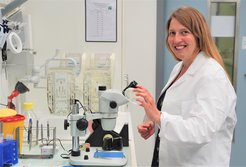Unraveling the secrets of RNA
New Max Planck Research Group "Bacterial Epitranscriptomics"
It happened in Göttingen, at the German Primate Center: student Katharina Höfer fell in love with the molecule RNA. Based on her fascination for chemistry, thanks to many opportunities for interdisciplinary cooperation, and already at that time provided with great freedom of research, the macromolecule has been her guiding principle ever since. During her doctoral thesis at Heidelberg University, she made a surprising discovery: NAD-RNA.

What is behind this acronym? Nicotinamide-adenine dinucleotide (NAD) is known as a redox factor for enzyme reactions. Based on Mass spectrometric investigations, Katharina Höfer and her research colleagues speculated that - contrary to the common paradigm – bacterial RNA might consist of more firmly integrated building blocks than the nucleotides adenine, guanine, cytosine and uracil.
Her fundamental discovery of NAD as a new, fifth building block of RNA turned the previous doctrine upside down. Particularly in bacteria such as E. coli, being considered as "well studied", this discovery opened up a new and unknown field of research. "One might say that E. coli is one of the best studied organisms so far. But there is still so much we do not know! I sometimes feel that we only know 10 percent of this bacterium," explains Katharina Höfer. "Now, for example, next-generation sequencing methods are available to us to discover and understand E. coli much better. This is research at its very core."
Katharina Höfer's goal is understanding the function of the new RNA building block. NAD is apparently always located at the beginning of RNA and seems to be a kind of “protective helmet” that increases the lifespan of RNA in bacteria. She also assumes that the NAD cap plays an important role in bacterial cell regulation. The NAD cap might be a sort of "molecular meeting point" for RNA-protein interactions in E. coli. Which proteins interact with the NAD-RNA? Do they affect localization? Is the NAD cap modified further? The answers to all of these questions should soon find their way into Biology textbooks.
Katharina Höfer chose the MPI in Marburg because, according to her, "there is a particularly supportive environment here.” Most importantly, SYNMIKRO, the Center for Synthetic Microbiology, which brings together scientists from the Philipps University of Marburg and the MPI under one roof. “In SYNMIKRO, we can network with structural biologists, chemists or computer scientists, for example, to better understand the function of NAD-RNAs in bacteria. Researching at the MPG means that we can be explorers. We have many ideas and we can test them. These are really fortunate circumstances."
However, her ideas are often not only based on the very latest methods. She also takes older works into consideration. "Right now we are celebrating a kind of revival of old, classical molecular biological methods to better characterize NAD-RNAs in bacteria. When you discover something new, such as NAD caps, you put a lot of time and energy into the development of even newer technologies. We are combining methods from the 1970s and 1980s with next generation sequencing, for example, and can thus revive the old, robust methods in the context of NAD-RNA. This way, when we are faced with a certain obstacle, we often quickly find a solution to better understand NAD-RNAs in bacteria. The combination of new and old is therefore an important part of our research group philosophy!”












